Multi-purpose helicopter Sikorsky CH-37 Mojave
The S-56 helicopter was one of the first helicopters in the world to transport heavy loads. In the version of the helicopter in the CH-37B Mojave version, the maximum carrying capacity on the external sling reached 4536 kg. Until the US Army Sikorsky CH-54 Tarhe entered service, the CH-37 helicopter remained the most heavy-duty army helicopter in the US Army.
The appearance of this helicopter was preceded by a competition that was announced by the US Marine Corps. In 1951, KMP ordered the Sikorsky company to develop a large amphibious helicopter that could take up to 26 soldiers and 3 jeep vehicles or 24 wounded people placed on stretchers. Loading and unloading was to be carried out through the folding nose of the helicopter fuselage. It is worth noting that the S-56 was the first twin-engined helicopter of the Sikorsky company. The helicopter was equipped with two engines R-2800-50, developing on 1900 hp each, which were installed at the ends of the short wing. Serial machines were equipped with more powerful engines R-2800-54, developing power in 2100 hp. The main landing gear was cleaned in the engine nacelles, this solution was first used on a production helicopter.
Approaching the creation of a new multi-purpose helicopter, I. I. Sikorsky decided to give the car the shape and size of the popular DC-3 “Dakota” transport aircraft. While working on the general view of the helicopter and its layout, the famous designer of Russian origin once again showed everyone his amazing ability to implement non-standard solutions. In order to free the entire fuselage of the car, making it more voluminous, Sikorsky decides to place both sufficiently powerful Pratt-Whitney R-2800 engines in the nacelles located on the horizontal pylons on the sides of the fuselage. These pylons had the shape of wings and in flight created additional lift, unloading the rotor of the machine. Inside the pylons were oil coolers and fuel tanks.
The use of such a layout had a positive effect on the operation of the engines in flight and simplified access to them during the necessary maintenance on the ground. In accordance with the rotorcraft concept fashionable in those years, Igor Sikorsky provided for the possibility of upgrading his S-56. To do this, it was necessary only to mount over a pulling propeller in front of each nacelle, as well as additional wings on them. Also on the sides of the fuselage could be suspended two additional fuel tanks.
Rotation of the rotor was carried out through transmission shafts, which were connected with the main gearbox, located in the pylon above the cargo compartment, and the steering screw - with the help of transmission shafts passing through the intermediate and tail gearboxes. These shafts turned out to be very long and while refining the helicopter its creators were faced with the appearance of resonance. In 1956, the so-called supercritical transmission shafts were used for the first time in the S-56 helicopter.
Main screw for the first time in stories Immediately received 5 blades. The design of this screw did not differ from what was used on the model S-55, but its size has increased significantly. The diameter of the main rotor at the time of the creation of this helicopter was the largest in the world. A successful scheme developed by the S-55 helicopter allowed Sikorsky to achieve undoubted success with his new car. The four-blade tail rotor was located on the end rail, which for the first time was shaped like a keel with a trimmer. Such a beam-keel made it possible to completely unload the tail rotor during the flight at high speed, increasing its service life and transmission resource, and also contributed to the reduction of fuel consumption. Behind on the fuselage of the machine was installed controlled stabilizer.
Initially, it was intended to install flaps on the pylons of the engine nacelle in order to reduce the resistance to blow losses on a hover, but after some time they decided to abandon this idea. For the first time in the world, the S-56 helicopter was equipped with an automatic folding of the main rotor blades and the end beam. Due to this, the required compactness was achieved with a deck-based helicopter. The streamlined helicopter fuselage was all-metal and made of magnesium alloys. The helicopter had an impressive cargo compartment length - 9,24 m, width - 2,36 m, and height - 2,03 m. The volume of the cargo compartment was 42,5 cubic meters. Inside the helicopter could easily accommodate up to 26 paratroopers or 3 jeep. For unloading and loading of passengers and cargo in the nose of the fuselage was made a hatch with two wings, which opened sideways, there was a ladder. At the same time, the equipment could enter the helicopter under its own power. In addition, there were two doors on the sides of the helicopter. A two-seater cabin and a cargo cabin were connected by a hatch. Oversized cargo (for example, a wedge M-56) could carry a helicopter on an external sling.
The “airplane” fuselage of the helicopter not only contributed to the improvement of the aerodynamic characteristics of the car, but also promoted the use of a landing gear with a tail wheel, which facilitated taxiing on the ground. The helicopter was very stable on the run after landing on autorotation, in addition, there was no danger of hitting the blade on the beam - a shortage of helicopters made in a single-rotor scheme common in those years. To achieve high speeds on a S-56 helicopter, a retractable landing gear was first implemented. The rear support was pulled directly into the fuselage, and the main support - in the engine nacelle.
The folding of the end beam and blades, the opening of the doors of the cargo hatch and the feeding of the ladder were carried out with the help of hydraulic drives, and the cleaning and release of the chassis required all of the designers' attention. They had to work on the system of joint and separate control of engines. In general, it can be noted that all the components and assemblies of the new multi-purpose helicopter turned out to be unique, not having world analogues at that time.
In total, the US Army ground forces ordered a Mojave 91 helicopter. At the beginning of the 1960s, most of the helicopters ordered, which were originally designated as H-37A, were converted to the H-37В version. The H-37В helicopter was distinguished by the presence of an autopilot, shock-proof fuel tanks, reinforced flaps of the forward cargo hatch, as well as a more advanced set of flight equipment. In 1962, the H-37A and H-37В helicopters were renamed CH-37A and CH-37В, respectively.
At the same time, the American army Mojave had the opportunity to enter the "warpath". In May 1963, the first 4 CH-37V helicopters were sent to Detachment A of the 19th aviation companies of the US Army located in Vietnam. Here they replaced the helicopters SN-21 "Shan" design Pyasetskogo. Later, heavy multi-purpose helicopters were introduced into the composition and other companies of the army aviation of the army. These helicopters proved to be extremely efficient machines during the evacuation of American aircraft shot down by the enemy. The carrying capacity of the CH-37 Mojave helicopters was enough to transport damaged aircraft without first disassembling them from the territory occupied by the enemy. From the autumn of 1963 to 1965, only two Mojave helicopters, which were assigned to the 611th company, were able to evacuate 139 damaged machines, including Bell UH-1 Iroquois and SN-21 Shani helicopters.
The US Army Marine Corps received 55 such helicopters, which were originally designated as HR2S-1 (since 1962 - SN-37C). Another 2 helicopters acquired the US Navy. These were the helicopter radar surveillance and early warning HR2S-1W in the deck version. The largest helicopters were installed on these helicopters ( navy) AN / APS-20E radar manufactured by General Electric. Antennas for these radars were installed under the cockpit in a bulging plastic cowl-shaped cowl. For a long time, the Sikorsky helicopter continued to be the most lifting and largest of the first-generation helicopters in series. In a record flight, which took place in November 1956, the N-37A army helicopter was able to lift a cargo weighing 6 tons to a height of 2000 meters and 5 tons to a height of 3688 meters. Good aerodynamic qualities coupled with a powerful propulsion system allowed Mojave to set an absolute record for flight speed - 262 km / h. The combination even now is amazing - the most lifting helicopter at that time was also the fastest.
For seven years of production, the company "Sikorsky" has released all X-NUMX helicopters S-156 of all modifications. Delays in the delivery of the machine adversely affected orders. In this case, the helicopter industry was already on the verge of switching to fundamentally new helicopter models equipped with more powerful gas turbine engines. For this reason, the US military preferred to save money to order more advanced machines. And the company "Sikorsky" has remained unfulfilled a number of very interesting modifications of the helicopter, in particular, the heavy anti-submarine and passenger version. But despite this, the multi-purpose helicopter CH-56 Mojave can be considered an outstanding event in the history of the helicopter. The machine taught a lot to American designers, raising the bar for creating helicopters to a new height.
Flight performance of the CH-37 Mojave:
Overall dimensions: length - 19,58 m, height - 6,71 m.
The diameter of the rotor - 21,95 m.
The diameter of the tail rotor - 4,57 m.
Normal take-off mass - 14 062 kg, empty mass - 9449 kg.
Fuel reserve - 1514 liters + 2271 liters optional.
The power plant is a Pratt Whitney R-2-2800 54 xPD, each 1566 kW.
The maximum flight speed is 209 km / h.
Cruising flight speed - 185 km / h.
Rate of climb - 277 m / min.
The range of action - 233 km.
Practical ceiling - 2650 m.
Static ceiling - 335 m.
Crew - 3 person.
The payload is up to 26 paratroopers or 24 injured on stretchers, up to 4536 kg of cargo in the cabin or on an external sling.
Information sources:
http://www.airwar.ru/enc/ch/ch37.html
http://www.aviastar.org/helicopters_rus/sik_s-56-r.html
http://aviadejavu.ru/Site/Crafts/Craft21857.htm
http://igor113.livejournal.com/465508.html
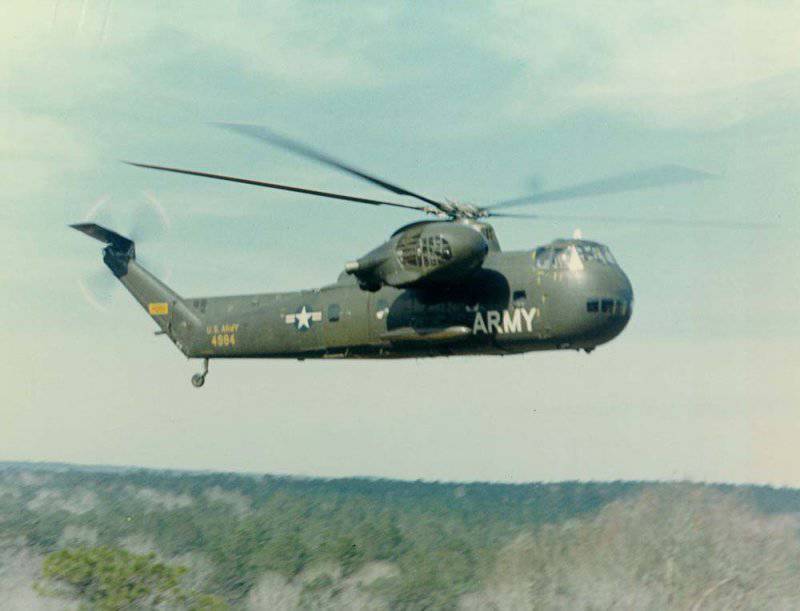
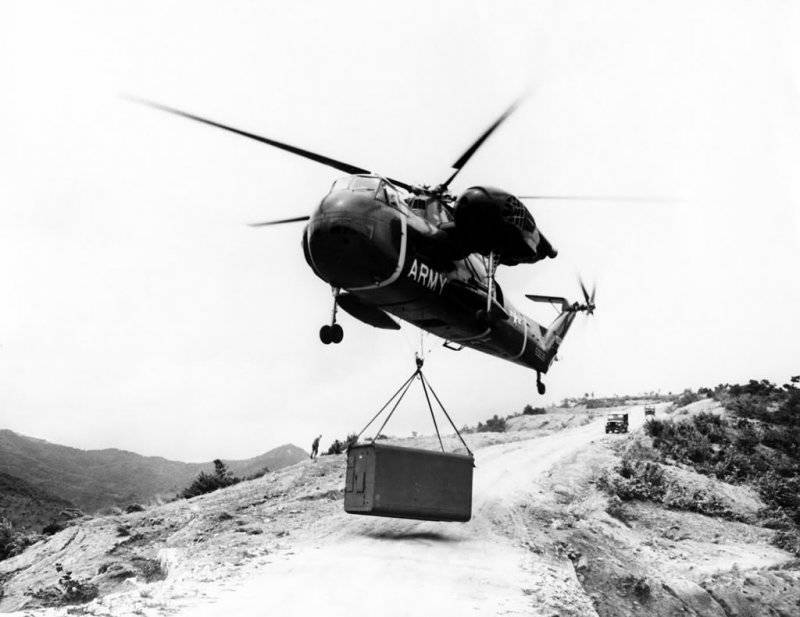
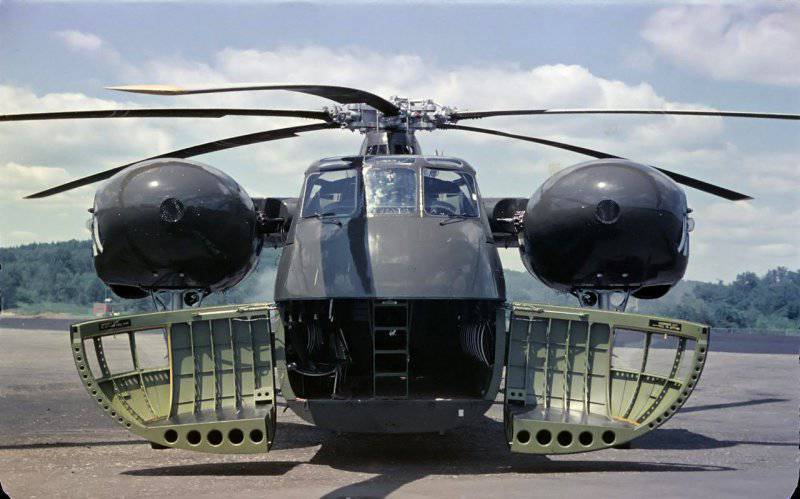
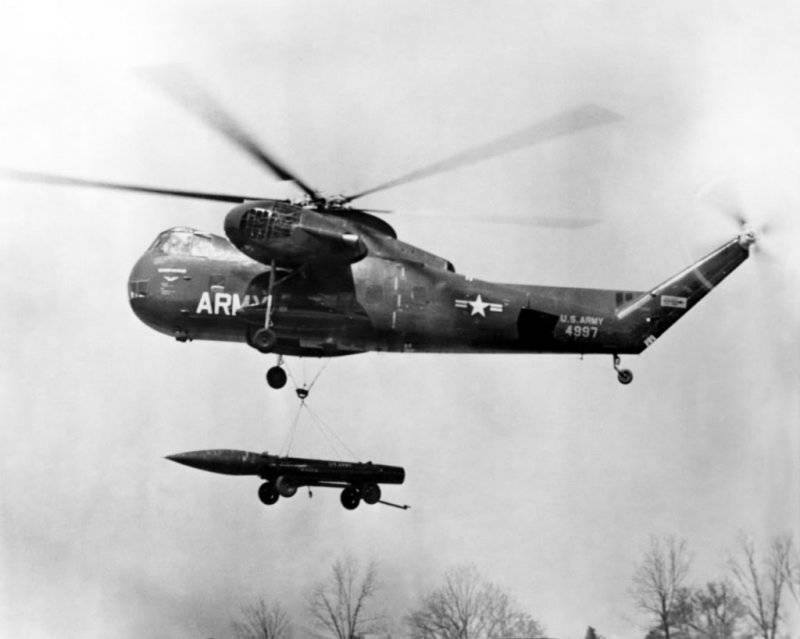
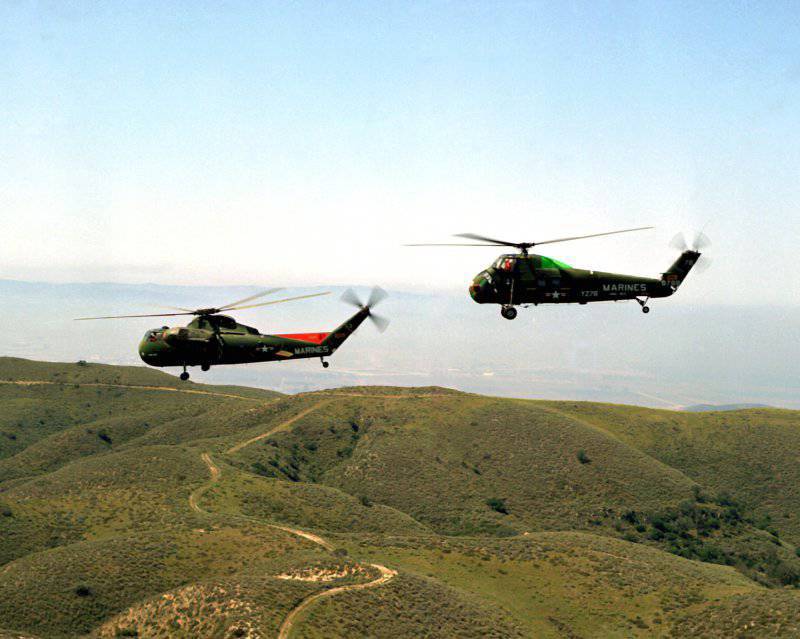
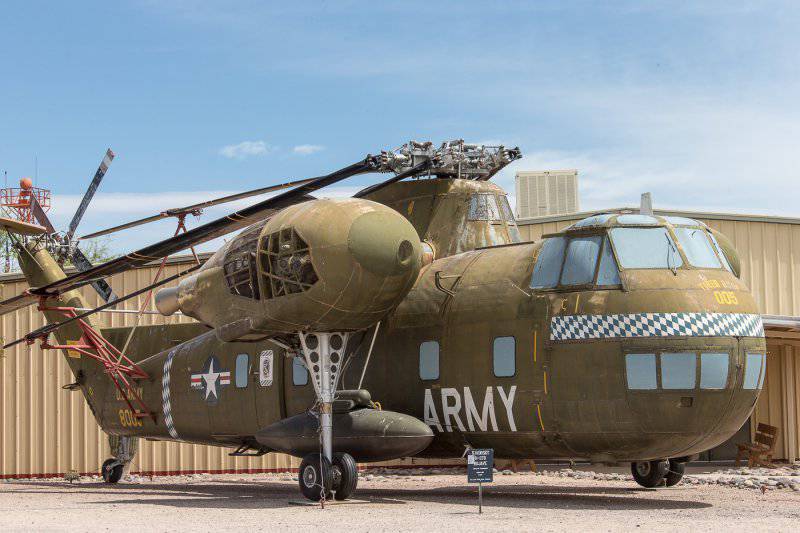
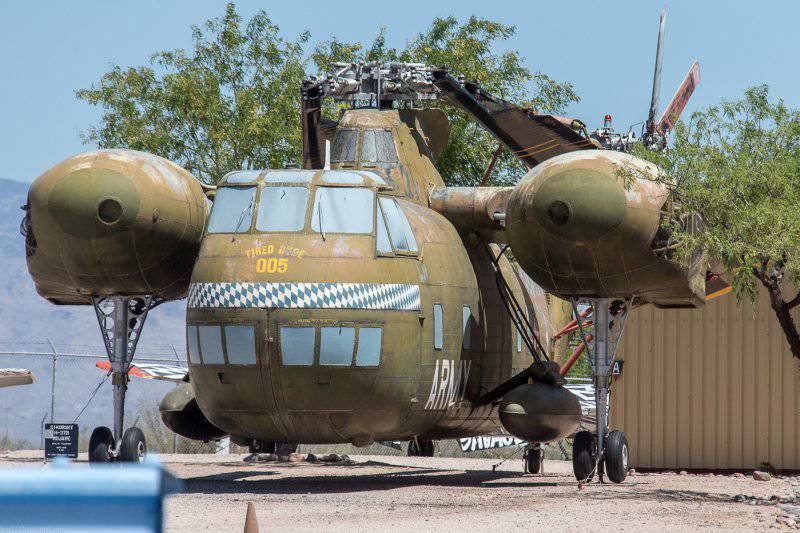
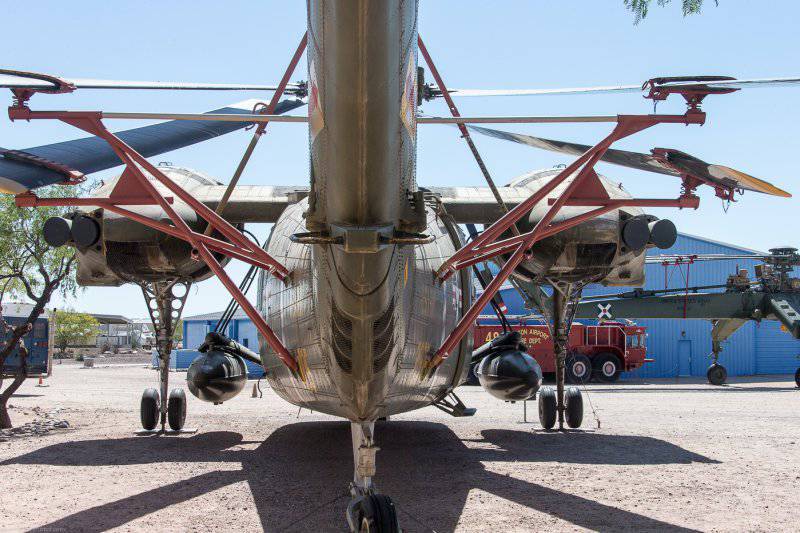
Information